Many use, but sometimes do not know, some features of the SACD format. In this post, I tried to publish basic information about the Super Audio CD. If you wish, you can search for more information about it on the Net (Please take a look links below). SACD is a high-resolution audio disc format that was developed by Sony and Philips Electronics. SACD is designed to provide high-resolution audio in both stereo and surround sound modes up to 5.1 channels. Not all discs will contain both stereo and surround tracks as this is dependent on the disc itself.
[ SACD https://www.facebook.com/groups/513381180836550/permalink/623196586521675/ ]
The SACD format uses a process known as Direct Stream Digital (DSD) to encode audio. DSD has a sampling rate of 2822.4kHz and the resolution is 1 bit. SACD recordings can have a wider frequency and dynamic range than conventional CDs.
There are three types of SACD discs:
Hybrid - This type of SACD contains an SACD layer compatible with SACD players, as well as a CD layer that is compatible with most standard Red Book CD players. Hybrid SACDs have a 4.7 GB SACD layer (the HD layer), as well as a CD (Red Book) audio layer readable by most conventional Compact Disc players. Single-layer - This type of SACD contains only one SACD layer compatible with SACD players, and does not contain a CD layer. This type of SACD will not play in a standard CD player.A disc with one 4.7 GB SACD layer.
Dual-layer - This type of SACD contains two SACD layers for additional data and no CD layer. This type of SACD will also not play in a standard CD player. A disc with two SACD layers, totaling 8.5 GB, and no CD layer. Dual-layer SACDs can store nearly twice as much data as a single-layer SACD. Like most dual-layer DVDs, the data spiral for the first layer is encoded from the inside out, and the second layer is encoded starting from the point where the first layer ends and ending at the innermost part of the disc.[citation needed] Unlike hybrid discs, both single- and dual-layer SACDs are incompatible with conventional CD players and cannot be played on them.
The most typical connection to an audio system for an SACD player is via 6-channel analog connections, thus allowing the SACD player to decode the high-resolution audio in the player and stream it to the audio system in an analog format. All current Rotel surround receivers and processors provide an analog multichannel input that would allow the connection of an SACD player.
Due to the large bandwidth required to transmit HD audio, the only digital cable with sufficient bandwidth to allow digital streaming of SACD audio is HDMI. However, most HDMI devices will not decode SACD as decoding a DSD signal requires a dedicated circuit solely for the purpose of SACD audio decoding. However, several players that do allow digital streaming of SACD discs will provide an option to convert the digital audio into a more standard PCM digital format, which is a standard digital audio signal that is compatible with most devices.
SACD discs have identical physical dimensions to standard compact discs. The areal density of the disc is the same as a DVD.
A stereo SACD recording has an uncompressed rate of 5.6 Mbit/s, four times the rate for Red Book CD stereo audio.
SUPER AUDIO CD TECHNOLOGY
To meet the defined quality objectives, an entirely new approach to audio recording and reproduction has been developed for Super Audio CD.
Based on the revolutionary new DSD (Direct Digital Stream) technology, Super Audio CD delivers superior sound quality with the ability to render all the nuances of a live performance. Using a sampling frequency of 2.8224 MHz - 64 times higher than that of CD - Super Audio CD offers a frequency response of up to 100 kHz and a dynamic range of up to 120 dB across the entire audible range.
Thanks to its DSD technology, Super Audio CD is able to offer audio reproduction of unmatched quality to both audiophile consumers and the music industry.
HYBRID DISC
The Hybrid Super Audio CD disc offers maximum compatibility because it consists of two layers. One layer carries the Super Audio CD content, while the other carries the same content in standard CD format.
It can be played both on any CD and DVD player and on Super Audio CD players. From the outside, the hybrid disc looks like a CD, with a diameter of 120 mm and a thickness of 1.2 mm. However, closer inspection shows that the disc is like a DVD disc, with two bonded 0.6 mm layers.
Because of its compatibility, Philips recommends that the replication industry adopts the Hybrid Super Audio CD disc. Hybrid Super Audio CD discs make it easier for consumers to migrate to the Super Audio CD format for all their new disc purchases. And they give disc retailers and distributors the benefit of one single disc that will meet the needs of all consumers, whether they wish to buy a CD or Super Audio CD discs.
MULTICHANNEL SOUND REPRODUCTION
Multichannel sound reproduction is one of the most distinctive and significant benefits of Super Audio CD technology.
The sound of Super Audio CD is available in both stereo and multichannel on a single disc. As well as the standard 2-channel stereo information, a Super Audio CD disc also carries up to 6 totally separate, full-bandwidth DSD channels. Each of these channels delivers a discrete audio signal of full Super Audio CD quality level.
AUTHORING
Super Audio CD disc authoring is the process that takes the studio output and processes it to create a Super Audio CD disc image suitable for replication, through which the final Super Audio CD discs are manufactured.
The following input data is required: Audio master tape in DSD format, Track marker information defining the start and stop time codes for each track, Table Of Contents (TOC) information, including album, disc, and track identification data, and (optional) Super Audio CD text information which can be displayed during playback
TEXT EDITOR
Text editing is the process that creates the (optional) text content which can be displayed during the playback of a Super Audio CD disc. The information displayed can include items such as performer, composer name, and other relevant items.
This can be performed conveniently using the SuperAuthor TOC Editor software, a limited version of the SuperAuthor Super Audio CD authoring package which is intended specifically for entering text items. This provides a clear, user-friendly interface that makes the task of entering, editing, and managing Super Audio CD text information easy and efficient.
Textual information on Super Audio CD can be provided in up to 8 separate text channels, each of which is defined with a specific language and character set. The text can also have a phonetic version, intended for non-Western languages such as Katakana or Hiragana.
At the album level, the text information can include a catalog number, up to 4 musical genres as well as the text information itself in up to 8 languages. At the disc level, the text contains a catalog number, date, another 4 genres, and text in 8 languages.

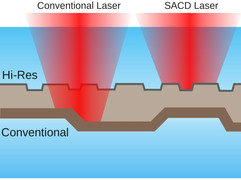


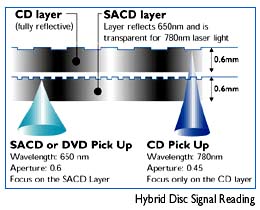

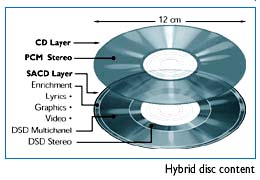



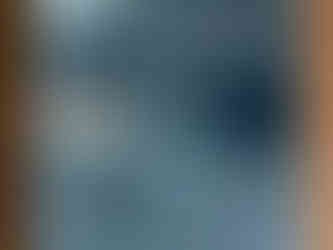

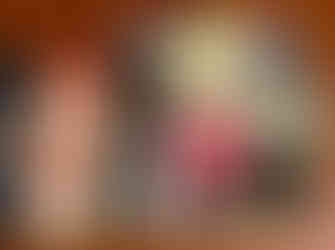


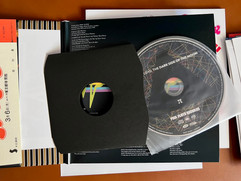
コメント